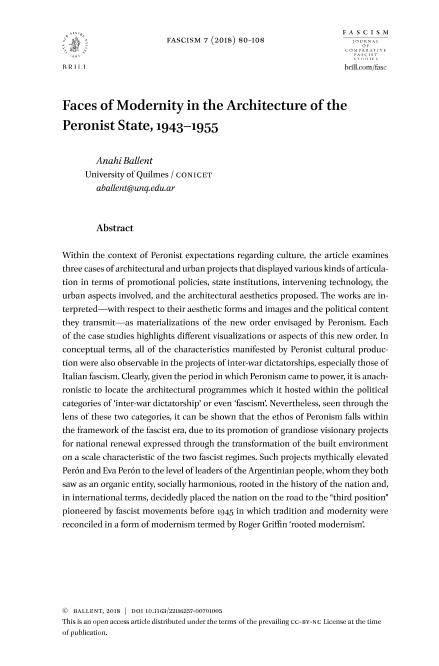Mostrar el registro sencillo del ítem
dc.contributor.author
Ballent, Anahi

dc.date.available
2022-11-07T19:04:41Z
dc.date.issued
2018-05
dc.identifier.citation
Ballent, Anahi; Faces of modernity in the architecture of the Peronist State, 1943-1955; Brill Academic Publishers; Fascism; 7; 1; 5-2018; 80-108
dc.identifier.issn
2211-6249
dc.identifier.uri
http://hdl.handle.net/11336/176779
dc.description.abstract
Within the context of Peronist expectations regarding culture, the article examines three cases of architectural and urban projects that displayed various kinds of articulation in terms of promotional policies, state institutions, intervening technology, the urban aspects involved, and the architectural aesthetics proposed. The works are interpreted - with respect to their aesthetic forms and images and the political content they transmit - as materializations of the new order envisaged by Peronism. Each of the case studies highlights different visualizations or aspects of this new order. In conceptual terms, all of the characteristics manifested by Peronist cultural production were also observable in the projects of inter-war dictatorships, especially those of Italian fascism. Clearly, given the period in which Peronism came to power, it is anachronistic to locate the architectural programmes which it hosted within the political categories of 'inter-war dictatorship' or even 'fascism'. Nevertheless, seen through the lens of these two categories, it can be shown that the ethos of Peronism falls within the framework of the fascist era, due to its promotion of grandiose visionary projects for national renewal expressed through the transformation of the built environment on a scale characteristic of the two fascist regimes. Such projects mythically elevated Perón and Eva Perón to the level of leaders of the Argentinian people, whom they both saw as an organic entity, socially harmonious, rooted in the history of the nation and, in international terms, decidedly placed the nation on the road to the "third position" pioneered by fascist movements before 1945 in which tradition and modernity were reconciled in a form of modernism termed by Roger Griffin 'rooted modernism'.
dc.format
application/pdf
dc.language.iso
eng
dc.publisher
Brill Academic Publishers

dc.rights
info:eu-repo/semantics/openAccess
dc.rights.uri
https://creativecommons.org/licenses/by-nc/2.5/ar/
dc.subject
ARCHITECTURE
dc.subject
ARGENTINIA
dc.subject
ESTHETICS AND POLITICS
dc.subject
FASCISM
dc.subject
MODERNISM
dc.subject
PERONISM
dc.subject
URBANISM
dc.subject.classification
Otras Historia y Arqueología

dc.subject.classification
Historia y Arqueología

dc.subject.classification
HUMANIDADES

dc.title
Faces of modernity in the architecture of the Peronist State, 1943-1955
dc.type
info:eu-repo/semantics/article
dc.type
info:ar-repo/semantics/artículo
dc.type
info:eu-repo/semantics/publishedVersion
dc.date.updated
2022-11-04T11:28:03Z
dc.identifier.eissn
2211-6257
dc.journal.volume
7
dc.journal.number
1
dc.journal.pagination
80-108
dc.journal.pais
Países Bajos

dc.journal.ciudad
Leiden
dc.description.fil
Fil: Ballent, Anahi. Consejo Nacional de Investigaciones Científicas y Técnicas; Argentina. Universidad Nacional de Quilmes. Departamento de Ciencias Sociales. Instituto de Estudios Sociales de la Ciencia y la Tecnología; Argentina
dc.journal.title
Fascism
dc.relation.alternativeid
info:eu-repo/semantics/altIdentifier/url/https://brill.com/view/journals/fasc/7/1/article-p80_80.xml
dc.relation.alternativeid
info:eu-repo/semantics/altIdentifier/doi/http://dx.doi.org/10.1163/22116257-00701005
Archivos asociados
